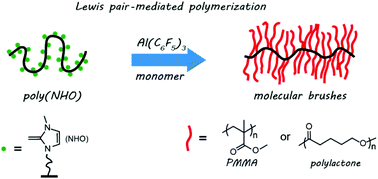Facile synthesis of cylindrical molecular brushes via Lewis pair-mediated polymerization†
Abstract
We demonstrate the first application of Lewis pair-mediated polymerization (LPP) in the efficient synthesis of cylindrical molecular brushes bearing poly(methyl methacrylate) and polylactone side chains. Poly(N-heterocyclic olefin) (poly(NHO)) as a macroinitiator precursor was firstly prepared by the reversible addition–fragmentation chain transfer (RAFT) polymerization of N-vinylimidazolium iodide and successive deprotonation in the presence of a strong base. Poly(NHO) together with Al(C6F5)3 can jointly promote the polymerization of methyl methacrylate and δ-valerolactone, leading to the formation of PMMA and polylactone side chains along the backbone via the grafting-from approach. NMR, GPC, AFM characterization and polymerization dynamic investigation indicate the successful formation of side chains and the resulting stretched conformation of the polymer backbone. DSC characterization reveals that molecular brushes have a higher glass transition temperature than their linear counterpart because of the branched architecture of molecular brushes. The current strategy represents a new avenue for the application of LPP and provides potential in the synthesis of polymers with well-defined topological structures.



 Please wait while we load your content...
Please wait while we load your content...